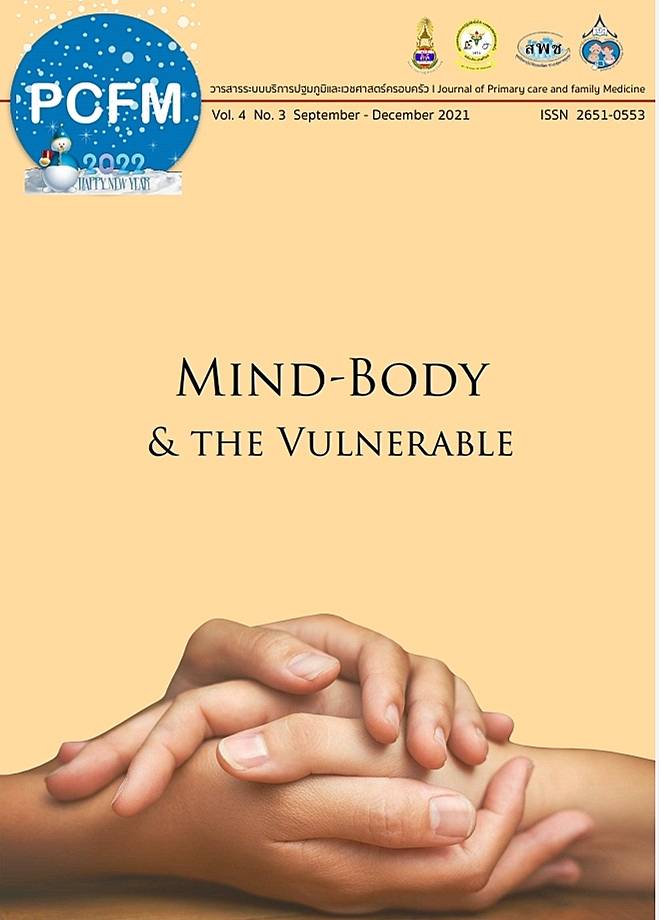การศึกษาลักษณะผู้ป่วยประคับประคองในหอผู้ป่วยแผนกอายุรกรรม โรงพยาบาลนครปฐม
Main Article Content
บทคัดย่อ
วัตถุประสงค์: เพื่อศึกษาลักษณะผู้ป่วยที่ควรได้รับการดูแลแบบประคับประคองในแผนกอายุรกรรม โรงพยาบาลนครปฐม
วิธีการศึกษา: แบบ Cross sectional study เก็บข้อมูลจากผู้ป่วยในที่ควรได้รับการดูแลแบบประคับประคองตามเกณฑ์
The Supportive and Palliative Care Indicators Tool 2019 (SPICT™ 2019) ที่หอผู้ป่วยวิกฤตและหอผู้ป่วยทั่วไป
แผนกอายุรกรรม โรงพยาบาลนครปฐม ตั้งแต่ ก.ค. 2563 ถึง ม.ค. 2564 เก็บข้อมูลจากแบบบันทึกการรักษาผู้ป่วยใน
ผลการศึกษา: ผู้ป่วยที่ควรได้รับการดูแลแบบประคับประคองตามเกณฑ์ SPICT™ 2019 จำนวน 262 คน พบผู้ป่วยที่ส่งปรึกษาแผนกการดูแลแบบประคับประคองจำนวน 40 คน (15.27%) จากหอผู้ป่วยสามัญ 22 คน และหอผู้ป่วยพิเศษ 18 คน โดยเป็นผู้ป่วยกลุ่ม Cancer จำนวน 32 คน (80.00%) สัดส่วนผู้ป่วยที่เข้าเกณฑ์การดูแลประคับประคอง ชนิดของมะเร็ง Palliative performance scale และสาเหตุการนอนโรงพยาบาลในผู้ป่วยกลุ่มที่ส่งปรึกษาแผนกการดูแลแบบประคับ ประคองและกลุ่มที่ไม่ได้ส่งปรึกษาแผนกการดูแลแบบประคับประคองมีความแตกต่างกันอย่างมีนัยสำคัญทางสถิติ การได้รับหัตถการ Endotracheal tube insertion ในผู้ป่วยที่ส่งปรึกษาแผนกดูแลแบบประคับประคองน้อยกว่าผู้ป่วยที่ไม่ได้ส่งปรึกษาแผนกดูแลแบบประคับประคอง (15.38% VS 26.47%, P-value < 0.001) และได้รับการทำ Advance care plan อย่างเป็นลายลักษณ์อักษรมากกว่า (100% VS 20.27%, P-value < 0.001)
สรุป: ผู้ป่วยที่ส่งปรึกษาแผนกดูแลแบบประคับประคองมีจำนวนน้อย ผู้ป่วยในหอผู้ป่วยวิกฤติและผู้ป่วยในกลุ่มที่ไม่ใช่โรคมะเร็งยังไม่เข้าถึงบริการการดูแลแบบประคับประคอง การส่งปรึกษาแผนกดูแลแบบประคับประคองทำให้ผู้ป่วยได้ทำ Advance care plan มากกว่า และใส่ท่อช่วยหายใจน้อยกว่าผู้ป่วยที่ไม่ได้ส่งปรึกษาแผนกดูแลแบบประคับประคอง
Article Details
เนื้อหาและข้อมูลในบทความที่ลงตีพิมพ์ในวารสาร PCFM ถือเป็นข้อคิดเห็นและความรับผิดชอบของผู้เขียนบทความโดยตรง ซึ่งกองบรรณาธิการวารสารไม่จำเป็นต้องเห็นด้วยหรือร่วมรับผิดชอบใด ๆ
บทความ ข้อมูล เนื้อหา รูปภาพ ฯลฯ ที่ได้รับการตีพิมพ์ลงในวารสาร PCFM ถือเป็นลิขสิทธิ์ของวารสาร PCFM หากบุคคลหรือหน่วยงานใดต้องการนำทั้งหมดหรือส่วนหนึ่งส่วนใดไปเผยแพร่ต่อหรือเพื่อกระทำการใด ๆ จะต้องได้รับอนุญาตเป็นลายลักษณ์อักษรจากวารสาร PCFM ก่อนเท่านั้น
เอกสารอ้างอิง
2. Natprayut N. The point-prevalence of palliative patients who were hospitalized in tertiary care hospital of Thailand. The Clinical Academia. 2019;43(6):220-8.
3. Cook D, Rocker G. Dying with Dignity in the Intensive Care Unit. New England Journal of Medicine. 2014;370(26):2506-14.
4. Elsayem A, Swint K, Fisch MJ, Palmer JL, Reddy S, Walker P, et al. Palliative care inpatient service in a comprehensive cancer center: clinical and financial outcomes. Journal of Clinical Oncology. 2004;22(10):2008-14.
5. Gomes B, Calanzani N, Curiale V, McCrone P, Higginson IJ. Effectiveness and cost‐effectiveness of home palliative care services for adults with advanced illness and their caregivers. Cochrane Database of Systematic Reviews. 2013(6).
6. Morrison RS, Penrod JD, Cassel JB, Caust-Ellenbogen M, Litke A, Spragens L, et al. Cost savings associated with US hospital palliative care consultation programs. Archives of internal medicine. 2008;168(16):1783-90.
7. Kyeremanteng K, Gagnon L-P, Thavorn K, Heyland D, D’Egidio G. The impact of palliative care consultation in the ICU on length of stay: a systematic review and cost evaluation. Journal of intensive care medicine. 2018;33(6):346-53.
8. Casarett D, Teno J. Why Population Health and Palliative Care Need Each Other. JAMA. 2016;316(1):27-8.
9. Sripaew S, Fumaneeshoat O, Ingviya T. Systematic adaptation of the Thai version of the supportive and palliative care indicators tool for low-income setting (SPICT-LIS). BMC Palliative Care. 2021;20(1):1-9.
10. De Bock R, Van Den Noortgate N, Piers R. Validation of the supportive and palliative care indicators tool in a geriatric population. Journal of palliative medicine. 2018;21(2):220-4.
11. Pantilat SZ, Billings JA. Prevalence and structure of palliative care services in California hospitals. Archives of internal medicine. 2003;163(9):1084-8.
12. Alliance WPC, Organization WH. Global atlas of palliative care at the end of life. London: Worldwide Palliative Care Alliance. 2014.
13. Fumaneeshoat O. Prevalence of the Z515 (Palliative Care) Diagnosis from the ICD-10 System in Cancer Patients and the Relationship between Treatment and Cost in Songklanagarind Hospital. Journal of Health Science and Medical Research. 2018:269-76.
14. W S, S P. A Retrospective, Single Center, Observational Study, Comparing the Direct Cost of End-Of-Life Care Patients with Advanced Cancer Care: Palliative Care versus Usual Care. Journal of Palliative Care & Medicine. 2016;06(01).


